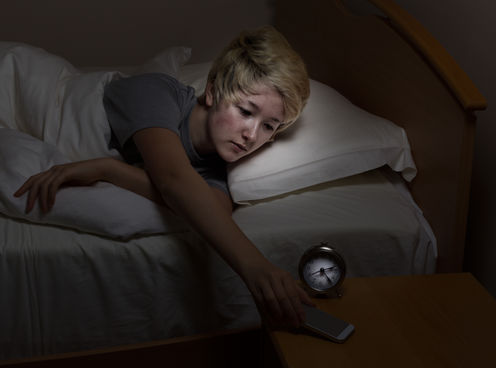
Bed-wetting is surprisingly common in older children and young adults. Lack of public awareness and stigma associated with bed-wetting means few seek professional help despite successful treatments being available.
Bed-wetting (enuresis) is a sleep problem. It occurs when individuals are unable to wake to urinate when the bladder is full.
Three main factors affect bed-wetting:
-
a large volume of urine produced at night which depends on the amount and type of drinks consumed (for example, alcohol is a diuretic), as well as the effect of inadequate amounts of the hormone vasopressin. Vasopressin is normally secreted in larger quantities at night causing the kidneys to make less urine. Some people secrete less vasopressin than normal during sleep, resulting in larger volumes of urine being produced.
-
a small bladder or a bladder that contracts more than normal during sleep and holds less urine at night. Caffeine and constipation can affect the bladder.
-
people who sleep deeply as well as those with sleep problems find it difficult to wake when the bladder is full during sleep. Tiredness, medication with a sedative effect, as well as alcohol can also affect sleep arousal.
Therefore, when the urine volume exceeds what the bladder is able to hold, wetting occurs if the person is unable to wake to void.
How common is it?
About 0.5-3% of teenagers and young adults wet the bed at night. Most of them have always wet, but 20% start after being previously dry (secondary enuresis). Reasons for secondary enuresis identified in young people include post-traumatic stress disorder and anorexia nervosa (with resolution of bed-wetting when their weight increases).
Unlike younger children, bed-wetting tends to persist and be more severe in older children and young adults, with 50-80% wetting at least three nights per week. Those with a history of bed-wetting associated with bladder problems and those with severe bed-wetting when they were younger are more likely to continue to wet as adults.
Impact of bed-wetting
Because of the stigma and shame associated with bed-wetting, its devastating impact on young people is often unappreciated. Studies have shown young people with bed-wetting have lower self-esteem and higher risk of depression.
Young adults have reported their condition has affected their work performance, choice of jobs, relationships and decision to have a life partner.
Treatments
Although effective treatments are available, most adults erroneously believe their problem is not treatable. Some 20-50% of young adults have never sought professional help about their problem, and continue to suffer in silence.
The principles for treating bed-wetting are the same for adults and children, and those who seek treatment usually respond well. However a quarter of young people have problems adhering to the treatment prescribed, suggesting a different approach may be needed for this population.
Urotherapy is conservative treatment centered around education and reinforcing good bladder and bowel habits such as drinking well, minimising caffeine and alcohol, going to the toilet regularly and managing constipation. Sometimes these simple measures can alleviate bed-wetting.
Desmopressin, a synthetically made vasopressin, has been effectively used in young people. Desmopressin decreases overnight urine production, increasing the likelihood of being dry and sleeping through the night. However, there is no sustained effect, and wetting usually recurs when desmopressin is stopped.
Imipramine, an antidepressant, is an older treatment that has also been used for bed-wetting. The exact mechanism of action is unknown but may be related to its effect on reducing spasm in the bladder. Imipramine has risks for serious side-effects such as irregular heart rhythm and treatment effects are not sustained when stopped.
Bed-wetting alarm training is one of the most effective treatments for bed-wetting, and the only one that has a sustained effect. Alarms train the individual to wake to urinate when their bladder is full and to withhold urinating at other times.
Bed-wetting alarm sensors are usually worn in the underpants or placed on the bed as a mat. They detect wetness and emit a noise or vibration. Arousal to the alarm signal and going to the toilet at that point is essential for treatment success. If the individual cannot wake to the alarm, they will need support from a family member or friend.
Although bed-wetting alarms are the treatment of choice for bed-wetting, young people may find alarm training embarrassing and difficult to do. Alarm training generally takes two to three months and can cease after 14 consecutive dry nights have been achieved.
Although treatments are available for older children at paediatric centres, there are currently no services for young adults. It is time to raise awareness that bed-wetting in young people is both common and treatable and to request more services and research to help this vulnerable population.
Patrina Ha Yuen Caldwell does not work for, consult, own shares in or receive funding from any company or organisation that would benefit from this article, and has disclosed no relevant affiliations beyond the academic appointment above.
